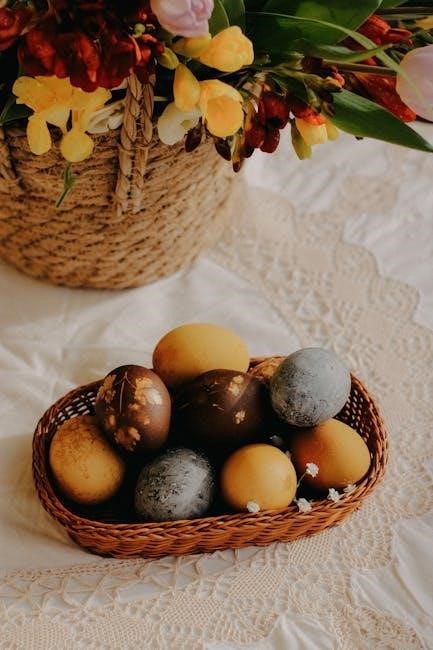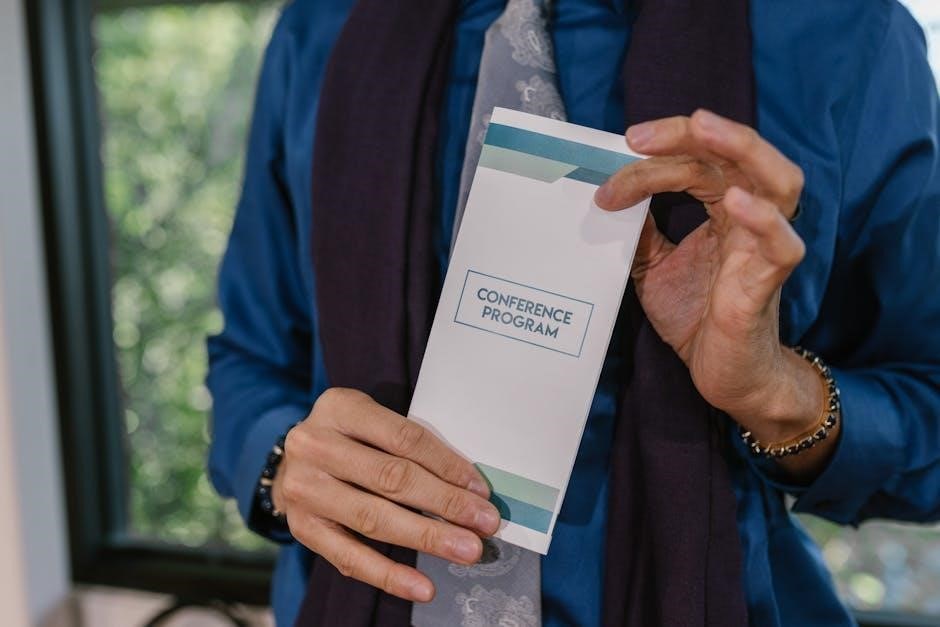Explore the vibrant world of Tulip Tie Dye with our comprehensive guide. Perfect for beginners and crafters, it offers step-by-step instructions for stunning, long-lasting designs easily.
Overview of Tulip Tie Dye Kits
Tulip Tie Dye Kits are a popular choice for crafters, offering a user-friendly, one-step process to create vibrant designs. These kits typically include pre-measured dye powders, squeeze bottles, gloves, and rubber bands, making it easy to get started. Designed for beginners, they eliminate the need for soaking fabric in soda ash, streamlining the dyeing process. The kits are known for producing bright, washable colors when instructions are followed. They also come with a guide, often available as a downloadable PDF, ensuring users have clear step-by-step directions. With Tulip Tie Dye Kits, anyone can achieve professional-looking results, making them a great option for creative projects like t-shirts, socks, or home decor items.
Importance of Following Instructions
Following the instructions provided in the Tulip Tie Dye PDF guide is crucial for achieving the best results. The kit’s success relies on proper preparation, mixing, and application techniques. Deviating from the steps can lead to issues like uneven dye distribution or faded colors over time. The instructions are specifically designed to ensure vibrant, long-lasting results. By adhering to the guidelines, users can avoid common mistakes and maximize the kit’s potential. The PDF guide offers clear, step-by-step directions, making it easier to achieve professional-looking tie-dye projects. Proper technique and timing are essential for the dye to bind effectively to the fabric, ensuring colors remain bright and durable through multiple washes.
Materials Needed for Tulip Tie Dye
Gather essential supplies, including the Tulip Tie Dye Kit, gloves, goggles, and plastic-covered workspace. Ensure all materials are ready before starting your creative project.
Tulip Tie Dye Kit Components
The Tulip Tie Dye Kit includes pre-measured dye powders, squeeze bottles, rubber bands, and detailed instructions. These components simplify the process, ensuring vibrant results for crafters of all skill levels.
Additional Supplies Required
Beyond the kit, you’ll need a few extra items for a smooth tie-dye experience. These include protective gloves, plastic sheets or table covers, and a bucket for rinsing. Having these on hand ensures your workspace stays clean and your project turns out as expected.
Preparation Steps for Tie Dye
Start by pre-washing fabric to remove finishes. Secure fabric with rubber bands, set up a protected workspace, and gather all necessary supplies before applying dye.
Pre-Washing Fabric
Pre-washing fabric is crucial to ensure optimal dye absorption. Wash the fabric in cold water with a mild detergent to remove any finishes or residues. Avoid using fabric softeners or bleach, as they can interfere with the dye. Gently agitate the fabric during washing, then rinse thoroughly. Do not dry the fabric in a dryer; instead, let it air dry or leave it slightly damp before securing with rubber bands. This step ensures the dye adheres evenly and prevents unwanted resist areas. Proper pre-washing sets the foundation for vibrant, long-lasting colors in your Tulip Tie Dye project. Always follow the instructions provided in the Tulip Tie Dye Instructions PDF for best results.
Securing Fabric with Rubber Bands
Securing fabric with rubber bands is a fundamental step in creating unique tie-dye patterns. Fold, twist, or pleat the fabric into the desired shape, then tightly wrap rubber bands around it to form resistance areas where the dye cannot penetrate. Experiment with different techniques, such as binding fabric into concentric circles, accordion folds, or bulb shapes, to achieve distinctive designs. The tighter the rubber bands, the sharper the pattern will be. Ensure the fabric is damp but not soaking wet before applying the bands for optimal results. Properly securing the fabric ensures vibrant, well-defined colors and a professional finish. Follow the Tulip Tie Dye Instructions PDF for detailed guidance on various folding methods and band placement.
Protective Gear and Workspace Setup
Protective gear and proper workspace setup are crucial for a safe and successful tie-dye experience. Wear gloves to prevent skin staining and goggles to protect your eyes from dye splashes. Cover your work surface with plastic sheets, newspaper, or a drop cloth to avoid permanent stains. Ensure good ventilation to avoid inhaling dye fumes. Organize your supplies, such as rubber bands, dye bottles, and buckets, within easy reach. Use squeeze bottles from the Tulip Tie Dye Kit to apply dye precisely. Keep a sink or water source nearby for rinsing. By setting up your workspace thoughtfully and wearing protective gear, you can enjoy a fun and mess-free tie-dye project. Proper preparation ensures a smooth process and professional-looking results.
Dye Application Process
Apply dye evenly using squeeze bottles from the Tulip Tie Dye Kit. Mix dye powder with water, shake well, and squeeze onto fabric folds for vibrant results.
Mixing the Dye According to Instructions
Mixing the dye is a crucial step in achieving vibrant results. Tulip Tie Dye Kits simplify this process with pre-measured dye powder in squeeze bottles. Simply fill the bottle with water to the marked line, shake thoroughly, and the dye is ready to use. Ensure the powder dissolves completely for even color distribution. For best results, use warm water, as it helps the dye bind better to the fabric. Follow the instructions carefully to avoid over- or under-saturating the mixture. Proper mixing ensures bold, long-lasting colors. Some kits even offer accelerants like Tulip’s Two-Minute Tie Dye for faster setting. Always mix in a well-ventilated area and wear gloves to protect your skin.
Applying Dye to Fabric
Applying dye to fabric is an exciting step where creativity shines. With Tulip Tie Dye Kits, the squeeze bottles make it easy to apply dye directly to the fabric. Gently squeeze the dye onto the folded and banded fabric, ensuring even coverage. Work methodically to saturate both sides of the fabric for consistent results. Avoid over-saturating, as this can lead to color fading. Use a gentle, controlled motion to distribute the dye, allowing it to seep into the folds. For intricate patterns, focus on specific areas to achieve unique effects. Once applied, let the dye set for 6-8 hours or as per the instructions for optimal color retention. Some kits even offer accelerants to speed up the process, ensuring vibrant, long-lasting colors.

Setting the Dye
Allow the dye to set for 6-8 hours or use Tulip’s Two-Minute Tie Dye for faster results. Follow instructions carefully to ensure vibrant, long-lasting colors.
Setting Time and Conditions
For optimal results, allow the dye to set for 6–8 hours. This ensures vibrant colors and proper binding with the fabric. If time is limited, Tulip’s Two-Minute Tie Dye offers a faster alternative without compromising quality. Keep the dyed fabric away from direct sunlight during the setting process to prevent color fading. Maintain room temperature conditions, as extreme heat or cold can affect dye absorption. Avoid rinsing prematurely, as this can weaken the color intensity. Following the recommended setting time and conditions ensures long-lasting, professional-looking tie-dye designs. Properly set dyes resist washing and retain their brightness over time.
Rinsing Excess Dye
Rinsing excess dye is a critical step to ensure vibrant, long-lasting colors. After the dye has set, gently remove the rubber bands and rinse the fabric under cold running water until the water runs clear. Avoid using hot water, as it may cause colors to bleed or fade. For delicate fabrics, rinse carefully to prevent damage. Do not wring or twist the fabric, as this can dislodge the dye unevenly. Proper rinsing removes loose dye particles, preventing unwanted color transfer during washing. Follow the Tulip Tie Dye Instructions PDF for specific guidance on rinsing techniques tailored to your project. This step is essential for achieving professional-looking results and maintaining color intensity.
Washing and Drying After Dyeing
Wash dyed fabrics separately in cold water using mild detergent. Avoid bleach or harsh chemicals. Dry inside out to protect colors. Follow care instructions for lasting vibrancy.
First Wash Instructions
After setting the dye, rinse the fabric gently under cold running water to remove excess dye. Turn the garment inside out to protect the design. Wash separately in cold water using a mild detergent. Avoid using bleach or harsh chemicals, as they can fade the colors. Gently agitate the fabric by hand or use a delicate cycle on your washing machine. Do not soak the fabric for extended periods, as this may weaken the dye bond. After washing, reshape the fabric to its original form and allow it to air dry away from direct sunlight. This ensures the colors remain vibrant and the fabric stays soft. Following these steps helps preserve the tie-dye design and maintains the integrity of the fabric. Proper care from the first wash onward is crucial for long-lasting results. Always refer to the Tulip Tie Dye Instructions PDF for specific guidance tailored to your project. By adhering to these instructions, you can enjoy your unique, hand-dyed creations for years to come.
Drying and Caring for Dyed Fabric
After the first wash, gently remove excess water without wringing the fabric. Reshape the garment while it’s damp to maintain its original form. Air dry the fabric away from direct sunlight to prevent fading. Avoid using a dryer, as heat can damage the fabric and cause colors to bleed. For ironing, use a low setting and iron inside out to protect the design. Avoid using fabric softeners or bleach, as they can weaken the dye bond. For future washes, turn the garment inside out and wash in cold water with a mild detergent. Wash dyed fabrics separately for the first few times to prevent color transfer. Proper care ensures vibrant colors and a long-lasting design. Refer to the Tulip Tie Dye Instructions PDF for detailed tips on maintaining your unique creations.
Exploring Different Tie Dye Techniques
Discover various tie dye techniques with Tulip’s guide, from simple folds to intricate designs. Explore layering colors and unique patterns for creative results. Follow the PDF instructions for success.
Basic Folding Techniques
Mastering basic folding techniques is essential for achieving unique tie dye patterns. Start by securing fabric with rubber bands to create resistance areas for the dye. The spiral fold involves twisting the fabric into a swirl shape, while the accordion fold creates straight, linear patterns. The bullseye fold involves folding the fabric into concentric circles, resulting in a target-like design. These simple methods allow for vibrant, distinct patterns. Always ensure folds are tight to prevent dye from spreading unevenly. For best results, follow the Tulip Tie Dye instructions PDF, which provides visual guides and step-by-step advice. Experiment with different folds to explore various design possibilities and achieve professional-looking results.
Advanced Folding Patterns
Take your tie dye to the next level with advanced folding patterns. The shibori fold creates intricate, geometric designs by folding fabric into precise shapes and securing with rubber bands. For a more complex look, try pleating, where fabric is folded into small, even layers. Another technique is folding fabric into 3D shapes, like cubes or cylinders, to create unique dye distribution. These methods allow for detailed, multi-dimensional patterns. To achieve the best results, follow the Tulip Tie Dye instructions PDF, which offers step-by-step guidance. Experiment with layering colors and folding techniques to create one-of-a-kind designs. Advanced folding requires patience but yields stunning, professional-quality results.
Layering Colors for Unique Effects
Layering colors is a creative way to achieve unique effects in tie dye. By applying multiple colors in layers, you can create vibrant, multi-dimensional designs. Start with a base color, then add subsequent layers, allowing each to set slightly before applying the next. This technique works best when using the Tulip Tie Dye instructions PDF, which provides guidance on mixing and applying dyes. To avoid muddying colors, ensure each layer is applied thinly and evenly. Experiment with contrasting hues for bold results or similar shades for subtle gradients. For optimal effects, wait a few minutes between layers to allow the dye to begin setting. This method is perfect for creating intricate, professional-quality designs. Always follow safety precautions and enjoy the artistic process of layering colors.

Troubleshooting Common Issues
Address common tie-dye problems like color fading or uneven distribution by referring to the Tulip Tie Dye Instructions PDF. It offers solutions and tips for vibrant results.
Why Colors May Fade
Colors may fade due to improper dye application or not following instructions. Over-saturating fabric or insufficient setting time can lead to fading. Ensure fabric is pre-washed and rubber bands are tight. Avoid using too much water, as it dilutes dye intensity. Inconsistent mixing or incomplete coverage also causes uneven results. Always rinse gently and wash separately. The Tulip Tie Dye Instructions PDF provides detailed guidance to prevent fading and achieve vibrant, long-lasting colors. By adhering to these steps, you can maintain the brilliance of your tie-dye projects. Proper care ensures colors remain vivid for years to come.
Fixing Uneven Dye Distribution
Uneven dye distribution can occur due to insufficient dye application or improper folding techniques. To fix this, check if fabric is evenly saturated and ensure rubber bands are tightly secured. If dye is too diluted, remix according to instructions and reapply. For light areas, gently pat with a damp cloth and add more dye. Allow the dye to set longer to ensure penetration. After rinsing, inspect the fabric; if areas are still uneven, repeat the dyeing process. Proper preparation and adherence to the Tulip Tie Dye Instructions PDF can help achieve a balanced, vibrant result. Regularly checking the fabric during the dyeing process ensures an even distribution of color.

Using Tulip Tie Dye Instructions PDF
The Tulip Tie Dye Instructions PDF provides a detailed, step-by-step guide for achieving professional-quality results. It includes visual aids and troubleshooting tips to enhance your dyeing experience.
Where to Find the PDF Guide
The Tulip Tie Dye Instructions PDF is readily available on the official Tulip Color Crafts website, ensuring easy access for all craft enthusiasts. Additionally, it can be found on popular craft supply websites, such as Jo-Ann Fabric and Craft Stores, and Michael’s. Many online marketplaces like Amazon also provide downloadable versions of the guide. Some retailers include a printed copy of the instructions within their Tulip Tie Dye kits. For convenience, Tulip often offers a direct link to the PDF on their product pages. This ensures that users can quickly access the detailed guide without hassle. The PDF is a valuable resource for both beginners and experienced crafters, offering step-by-step guidance and visual aids to achieve the best results.
Benefits of the PDF Instructions
The Tulip Tie Dye Instructions PDF offers numerous benefits, making it an essential tool for crafters. It provides clear, step-by-step guidance, ensuring a smooth and successful tie-dye experience. The PDF includes detailed illustrations and troubleshooting tips, addressing common issues like color fading or uneven dye distribution. This resource is particularly helpful for beginners, as it explains each stage of the process, from preparation to final care. Additionally, the PDF is easily accessible and can be downloaded or printed for convenience. It serves as a comprehensive reference, allowing users to achieve professional-quality results with minimal effort. The guide also highlights eco-friendly practices, promoting sustainability in the tie-dye process; Overall, the PDF enhances creativity and confidence, making it indispensable for anyone exploring Tulip Tie Dye.

Safety and Sustainability
Ensure safe and eco-friendly tie-dyeing by wearing protective gear and using non-toxic dyes. Tulip kits promote sustainability with washable, vibrant colors.
Safety Precautions When Using Dye
When working with Tulip Tie Dye, prioritize safety by wearing protective gloves and goggles to avoid skin and eye irritation. Ensure good ventilation to prevent inhaling dye particles.
Keep dye away from children and pets. While Tulip dyes are non-toxic, improper handling can still cause discomfort. Wash hands thoroughly after use and clean spills immediately.
Eco-Friendly Tips for Tie Dye
Adopt sustainable practices while enjoying Tulip Tie Dye. Opt for natural, organic fabrics like cotton or linen, which absorb dye better and are eco-friendly. Minimize water waste by planning projects in batches and using leftover dye for smaller items. Repurpose old clothing or fabric scraps to reduce waste. Choose Tulip’s non-toxic, machine-wash-safe dyes for safer environmental impact. After rinsing excess dye, collect water for gardening or other non-potable uses. Properly dispose of leftover dye and materials. By following these tips, you can create vibrant tie-dye designs while promoting sustainability and reducing your environmental footprint.
Tulip Tie Dye offers a fun and creative way to personalize fabrics with vibrant, long-lasting colors. By following the provided instructions and tips, you can achieve professional-quality results. The Tulip Tie Dye Instructions PDF is an invaluable resource, ensuring success for both beginners and experienced crafters. Remember to explore different techniques, embrace sustainability, and enjoy the process of transforming plain fabrics into unique, eye-catching designs. With proper care, your tie-dye creations will remain colorful and cherished for years. Happy crafting!